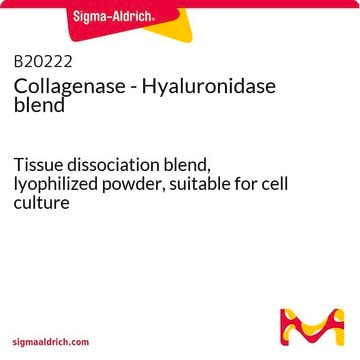B20221
Collagenase-DNase I blend
Tissue dissociation blend, lyophilized powder, suitable for cell culture
About This Item
Productos recomendados
Quality Level
form
lyophilized powder
specific activity
(Collagenase (FALGPA assay) 1.0-5.0 units/ml in 10 ml HBSS (#H6648))
(Deoxyribonuclease I activity: 200-2000 Kunitz units/ml in 10 ml HBSS (#H6648))
storage temp.
-10 to -25°C
General description
Biochem/physiol Actions
Preparation Note
signalword
Danger
hcodes
pcodes
Hazard Classifications
Resp. Sens. 1
Storage Class
13 - Non Combustible Solids
wgk_germany
WGK 3
flash_point_f
Not applicable
flash_point_c
Not applicable
Certificados de análisis (COA)
Busque Certificados de análisis (COA) introduciendo el número de lote del producto. Los números de lote se encuentran en la etiqueta del producto después de las palabras «Lot» o «Batch»
¿Ya tiene este producto?
Encuentre la documentación para los productos que ha comprado recientemente en la Biblioteca de documentos.
Artículos
Discover pre-mixed collagenase enzyme blends with DNase I, Dispase II, Elastase, and Hyaluronidase and gently dissociate animal tissues in vitro.
Nuestro equipo de científicos tiene experiencia en todas las áreas de investigación: Ciencias de la vida, Ciencia de los materiales, Síntesis química, Cromatografía, Analítica y muchas otras.
Póngase en contacto con el Servicio técnico








